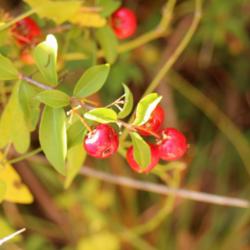
Dwarf cherry trees are most productive when trained to a central leader. The lowest branch should be about 2 feet off the ground, and the limbs should be spaced at least 8 inches apart. Train semidwarf or standard-size trees to a modified leader. Prune the trees every year in late winter to encourage new fruiting wood to grow. After harvest, cut back overvigorous branches to control the size of the tree. Summer pruning can be done any time until early August; the later you prune, the smaller you'll keep the tree. Don't prune in the fall, as that leaves the tree more susceptible to winter injury.
Fertilizing CherriesControl grass or other competing vegetation around the tree for the first few years. A heavy mulch from the tree trunk to the tree's dripline helps conserve soil moisture and control weeds. Fertilize each spring until trees start to bear. Once bearing, cherries need little irrigation or fertilizer in most areas.
If you apply nitrogen to bearing trees, wait until after the fruit has been harvested, but apply it no later than midsummer. This will give the tree a boost toward producing plenty of sugars in its leaves to ripen next year's crop. To prepare the tree for winter, it's a good idea to paint tree trunks white or wrap them with white plastic tree guards. Pull mulch away from the trunk and be sure to harden the tree off.
Cherry Tree PestsBe on the lockout for problems with pests and diseases. In the southern parts of the tart cherry-growing area, the only worm to infest the fruit is the larva of the plum curculio, which also attacks sweet cherries. The cherry fruit fly may infest sweet cherries and tart cherries are susceptible to black cherry fruit flies. The apple maggot and peach tree borer may also cause problems.
Brown rot and cherry leaf spot affect both tart and sweet cherries. Black knot and powdery mildew are potential problems for some areas.
Prevent birds from decimating your crop with netting, scare tactics, or barrier-type controls.
HarvestingOne mature, standard-size tart or sweet cherry tree will produce 30 to 50 quarts of cherries a year; a dwarf tree, about 10 to 15 quarts. Wait until the cherries turn fully red to harvest them; the sugar content rises dramatically in the last few days of ripening. You'll need to go over the tree every other day for about a week. Pick the fruit with stems attached, but be careful not to tear off the woody fruit spur, which will continue to produce fruit year after year. If you're using a mechanical cherry pitter, pick the cherries by leaving the stems on the trees. Use these cherries up soon after you pick them because they'll leak juice and may spoil if left out. Using a hand-cranked cherry pitter, you can pit a quart of cherries in 10 minutes.
 Victory Seed Company has all the seeds you want for your best garden in 2024.
Victory Seed Company has all the seeds you want for your best garden in 2024.
For 25 years, the family-owned Victory Seed Company has provided the highest quality vegetable, herb and flower seeds to families across the country. We are passionate about providing you the best seeds available that give excellent germination, robust plants, and the harvest you want. With a catalog of over a thousand varieties, we have everything, and our prices are the kinds that we'd want to pay. We have hundreds of yesterday's heirloom vegetables, as well as today's award winning hybrid selections. Get to know us by visiting our website and browsing through our online vegetable seed catalog.
| 1. Cherry Essentials |
| 2. Planting Cherries |
| 3. Cherry Varieties |
| 4. Cherry Care & Harvesting ← you're on this article right now |
| 5. Preventing Birds on Cherry Trees |
| 1. Cherry Essentials |
| 2. Planting Cherries |
| 3. Cherry Varieties |
| 4. Cherry Care & Harvesting ← you're on this article right now |
| 5. Preventing Birds on Cherry Trees |